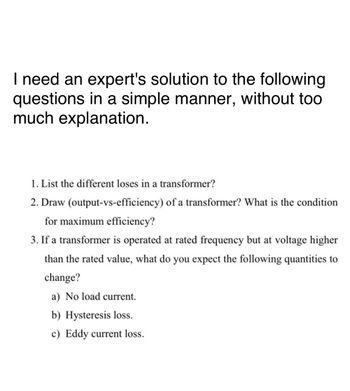
Electricity for Refrigeration, Heating, and Air Conditioning (MindTap Course List)
10th Edition
ISBN: 9781337399128
Author: Russell E. Smith
Publisher: Cengage Learning
expand_more
expand_more
format_list_bulleted
Question
thumb_up100%

Transcribed Image Text:I need an expert's solution to the following
questions in a simple manner, without too
much explanation.
1. List the different loses in a transformer?
2. Draw (output-vs-efficiency) of a transformer? What is the condition
for maximum efficiency?
3. If a transformer is operated at rated frequency but at voltage higher
than the rated value, what do you expect the following quantities to
change?
a) No load current.
b) Hysteresis loss.
c) Eddy current loss.
Expert Solution
This question has been solved!
Explore an expertly crafted, step-by-step solution for a thorough understanding of key concepts.
Step by stepSolved in 2 steps with 3 images

Knowledge Booster
Similar questions
- For a short-circuit test on a 2-winding transformer, with one winding shorted, can you apply the rated voltage on the other winding? (a) Yes (b) Noarrow_forwardFor the transformer in Problem 3.10. The open-circuit test with 11.5 kV applied results in a power input of 65 kW and a current of 30 A. Compute the values for GcandBm in siemens referred to the high-voltage winding. Compute the efficiency of the transformer for a load of 10 MW at 0.8 p.f. lagging at rated voltage.arrow_forwardWhat are the advantages of correctly specifying a transformer most Suita ble for its application?arrow_forward
- Consider an ideal transformer with N1=3000andN2=1000 turns. Let winding 1 be connected to a source whose voltage is e1(t)=100(1| t |)volts for 1t1ande1(t)=0 for | t |1 second. A2- farad capacitor is connected across winding 2. Sketch e1(t),e2(t),i1(t),andi2(t) versus time t.arrow_forwardThe symbol shown is a(n) a. iron core transformer. b. auto transformer. c. current transformer. d. air core transformer.arrow_forwardWhy is it important to reduce the moisture within a transformer to acceptable levels during transformer installation?arrow_forward
- The first picture is the question the second pic i did not understand that step of %75 of the load means what ?arrow_forward2-An ideal transformer consists of a primary winding (100 turn) and a secondary winding (1000 turn). The secondary winding is connected to a resistance (50 ohm). The amount of electric current in the secondary winding which equil to , when the voltage on the secondary winding is 100 voltsarrow_forwardQ1: During the separation of transformer core losses experiment: 1. Why should always keep the ratio of V/F constant? 2. If the transformer is operated at rated frequency but at voltage lower than rated value, how do you expect the following quantities to change? And why? i. Hysteresis loss ii. Eddy current loss ii. No-load current 3. If the ratio of V/F has been kept constant and the observed value of hysteresis loss at rated frequency of 50 Hz is 18 W, the measured value of core losses is 35 W, Find the total core losses at the frequency of 60 Hz. Q2: a) Determine the efficiency of three-phase 400 kVA, 11kV/ 380 V transformer at over-loading condition by 15% of its rated with unity power factor load. The copper and iron losses at full load are 16 kW, 4 kW respectively. b) State one or more of the ways to reduce the losses that taken place in transformers. Q3: At the parallel operation of three-phase transformers: a) Give an explanation for the following cases: i. Two-lamps are…arrow_forward
- 34arrow_forwardPlease explain the solutionarrow_forwardFlag this question for future reference What is the test that can be conducted in the laboratory to understand the transformer impedance drops are dependent on the load current with a variation in the secondary voltage? O a. Direct Load Test O b. Open Circuit Test OC. Voltage Ratio Test O d. Polarity Testarrow_forward
arrow_back_ios
SEE MORE QUESTIONS
arrow_forward_ios
Recommended textbooks for you
 Electricity for Refrigeration, Heating, and Air C...Mechanical EngineeringISBN:9781337399128Author:Russell E. SmithPublisher:Cengage Learning
Electricity for Refrigeration, Heating, and Air C...Mechanical EngineeringISBN:9781337399128Author:Russell E. SmithPublisher:Cengage Learning Power System Analysis and Design (MindTap Course ...Electrical EngineeringISBN:9781305632134Author:J. Duncan Glover, Thomas Overbye, Mulukutla S. SarmaPublisher:Cengage Learning
Power System Analysis and Design (MindTap Course ...Electrical EngineeringISBN:9781305632134Author:J. Duncan Glover, Thomas Overbye, Mulukutla S. SarmaPublisher:Cengage Learning

Electricity for Refrigeration, Heating, and Air C...
Mechanical Engineering
ISBN:9781337399128
Author:Russell E. Smith
Publisher:Cengage Learning

Power System Analysis and Design (MindTap Course ...
Electrical Engineering
ISBN:9781305632134
Author:J. Duncan Glover, Thomas Overbye, Mulukutla S. Sarma
Publisher:Cengage Learning
